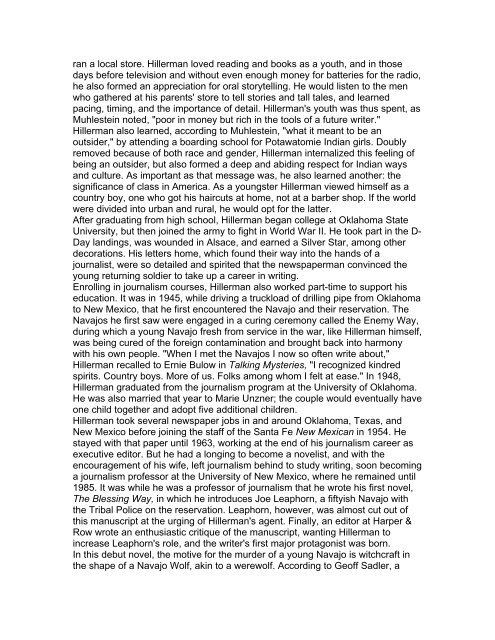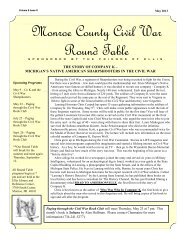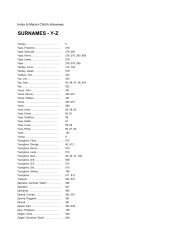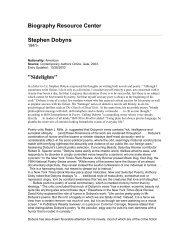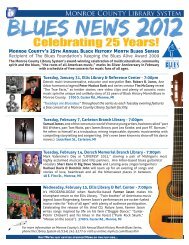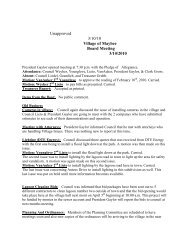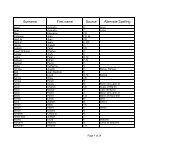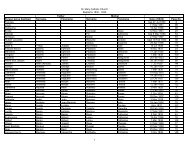Tony Hillerman Bio.pdf
Tony Hillerman Bio.pdf
Tony Hillerman Bio.pdf
You also want an ePaper? Increase the reach of your titles
YUMPU automatically turns print PDFs into web optimized ePapers that Google loves.
an a local store. <strong>Hillerman</strong> loved reading and books as a youth, and in those<br />
days before television and without even enough money for batteries for the radio,<br />
he also formed an appreciation for oral storytelling. He would listen to the men<br />
who gathered at his parents' store to tell stories and tall tales, and learned<br />
pacing, timing, and the importance of detail. <strong>Hillerman</strong>'s youth was thus spent, as<br />
Muhlestein noted, "poor in money but rich in the tools of a future writer."<br />
<strong>Hillerman</strong> also learned, according to Muhlestein, "what it meant to be an<br />
outsider," by attending a boarding school for Potawatomie Indian girls. Doubly<br />
removed because of both race and gender, <strong>Hillerman</strong> internalized this feeling of<br />
being an outsider, but also formed a deep and abiding respect for Indian ways<br />
and culture. As important as that message was, he also learned another: the<br />
significance of class in America. As a youngster <strong>Hillerman</strong> viewed himself as a<br />
country boy, one who got his haircuts at home, not at a barber shop. If the world<br />
were divided into urban and rural, he would opt for the latter.<br />
After graduating from high school, <strong>Hillerman</strong> began college at Oklahoma State<br />
University, but then joined the army to fight in World War II. He took part in the D-<br />
Day landings, was wounded in Alsace, and earned a Silver Star, among other<br />
decorations. His letters home, which found their way into the hands of a<br />
journalist, were so detailed and spirited that the newspaperman convinced the<br />
young returning soldier to take up a career in writing.<br />
Enrolling in journalism courses, <strong>Hillerman</strong> also worked part-time to support his<br />
education. It was in 1945, while driving a truckload of drilling pipe from Oklahoma<br />
to New Mexico, that he first encountered the Navajo and their reservation. The<br />
Navajos he first saw were engaged in a curing ceremony called the Enemy Way,<br />
during which a young Navajo fresh from service in the war, like <strong>Hillerman</strong> himself,<br />
was being cured of the foreign contamination and brought back into harmony<br />
with his own people. "When I met the Navajos I now so often write about,"<br />
<strong>Hillerman</strong> recalled to Ernie Bulow in Talking Mysteries, "I recognized kindred<br />
spirits. Country boys. More of us. Folks among whom I felt at ease." In 1948,<br />
<strong>Hillerman</strong> graduated from the journalism program at the University of Oklahoma.<br />
He was also married that year to Marie Unzner; the couple would eventually have<br />
one child together and adopt five additional children.<br />
<strong>Hillerman</strong> took several newspaper jobs in and around Oklahoma, Texas, and<br />
New Mexico before joining the staff of the Santa Fe New Mexican in 1954. He<br />
stayed with that paper until 1963, working at the end of his journalism career as<br />
executive editor. But he had a longing to become a novelist, and with the<br />
encouragement of his wife, left journalism behind to study writing, soon becoming<br />
a journalism professor at the University of New Mexico, where he remained until<br />
1985. It was while he was a professor of journalism that he wrote his first novel,<br />
The Blessing Way, in which he introduces Joe Leaphorn, a fiftyish Navajo with<br />
the Tribal Police on the reservation. Leaphorn, however, was almost cut out of<br />
this manuscript at the urging of <strong>Hillerman</strong>'s agent. Finally, an editor at Harper &<br />
Row wrote an enthusiastic critique of the manuscript, wanting <strong>Hillerman</strong> to<br />
increase Leaphorn's role, and the writer's first major protagonist was born.<br />
In this debut novel, the motive for the murder of a young Navajo is witchcraft in<br />
the shape of a Navajo Wolf, akin to a werewolf. According to Geoff Sadler, a


